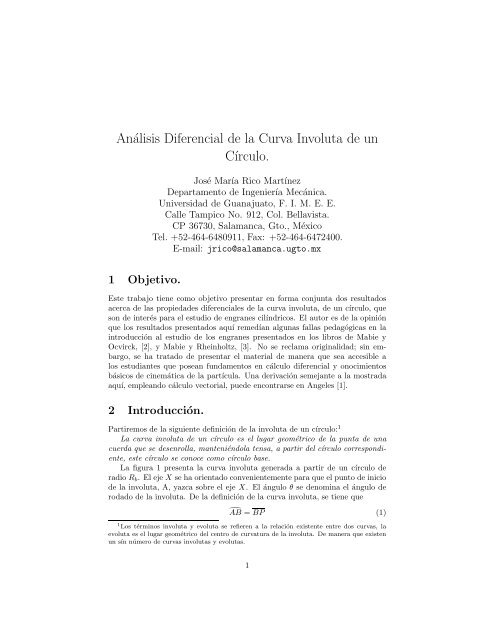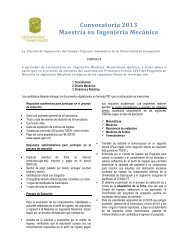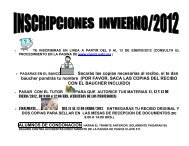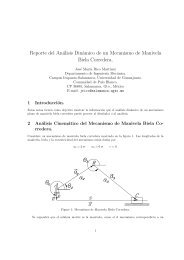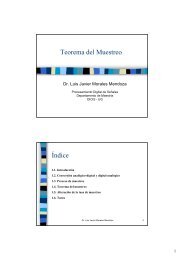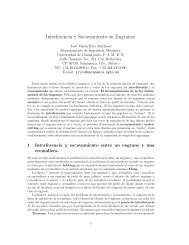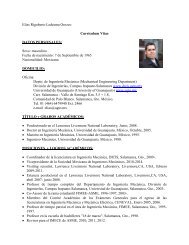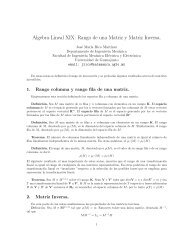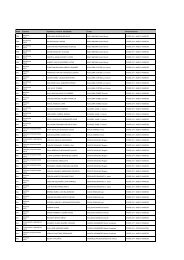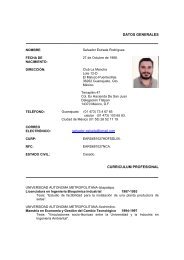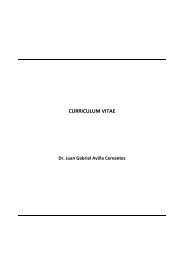Análisis Diferencial de la Curva Involuta de un C´ırculo.
Análisis Diferencial de la Curva Involuta de un C´ırculo.
Análisis Diferencial de la Curva Involuta de un C´ırculo.
You also want an ePaper? Increase the reach of your titles
YUMPU automatically turns print PDFs into web optimized ePapers that Google loves.
<strong>de</strong>terminarán <strong>la</strong>s seg<strong>un</strong>das <strong>de</strong>rivadas <strong>de</strong> <strong>la</strong>s coor<strong>de</strong>nadas <strong>de</strong> <strong>la</strong> curva involutad 2 xdψ 2 = rå d Cosψ− Senψdψ θå= dr Cosψè− Senψ − rå Senψè+ Cosψ + Cosψ dθdψ θθθ 2 (22)dψDebe notarse que, <strong>de</strong> <strong>la</strong>s ecuaciones (12, 13), se tiene queèdθdψ = dθ dφdφdψ = Sec2 φtan 2 φ = 1Sen 2 φSustituyendo <strong>la</strong>s ecuaciones (14, 23, 3) en <strong>la</strong> ecuación (22), se tiene queåd 2 xdψ 2 = r Cosψè− Senψ − rå Senψè+ Cosψ + Cosψθ θθθ 2 Sen 2 φå 2 Senψ è= −r + Cosψ 1+ 1 θθ 4Simi<strong>la</strong>rmente, <strong>la</strong> seg<strong>un</strong>da <strong>de</strong>rivada <strong>de</strong> y está dadapord 2 ydψ 2 = rå d Senψè+ Cosψdψ θå= dr Senψè+ Cosψ + rå Cosψ− Senψ − Senψ dθdψ θθθ 2 dψå= r Senψè+ Cosψ + rå Cosψè− Senψ −Senψθ θθθ 2 Sen 2 φå 2 Cosψ è= r − Senψ 1+ 1 θθ 4è(23)(24)(25)De <strong>la</strong> figura 1, el vector <strong>un</strong>itario normal, a <strong>la</strong> curva involuta, en el p<strong>un</strong>to P ,está dadoporê n = −Senθî + Cosθĵ. (26)Por lo tanto, <strong>la</strong> aceleración normal está dada pora n d2 x=dψ 2 î + d2 ydψ 2 ĵ · ê n = − d2 xdψ 2 Senθ + d2 ydψ 2 Cosθ= rå 2 Senψ è+ Cosψ 1+ 1 θθ 4 Senθ + rå 2 CosψθRecordando <strong>la</strong>s i<strong>de</strong>ntida<strong>de</strong>s trogonométricas− SenψSenφ = Sen(θ − ψ) =SenθCosψ − Cosθ SenψCosφ = Cos(θ − ψ) =CosθCosψ + SenθSenψ è1+ 1 θ 4 Cosθ5
se tiene quea n = r= rå 2θ (SenθSenψ + CosθCosψ) 1+ 1 θå 42 èθ Cosφ + 1+ 1 θ 4 Senφ = rCos φå 2 èθ += rCos φ1+ 1 θ 4θ(SenθCosψ − CosθSenψ)å 2θ + 1+ 1 θ4= rCos φ 2θ + 1+θ4θ 4 θ=tanφ= rCos φ (1 + θ2 ) 2θ 3 (28)Por otro <strong>la</strong>do, el cuadrado <strong>de</strong> <strong>la</strong> magnitud <strong>de</strong> <strong>la</strong> velocidad <strong>de</strong> <strong>un</strong>a partícu<strong>la</strong>que se <strong>de</strong>sp<strong>la</strong>za a lo <strong>la</strong>rgo <strong>de</strong> <strong>la</strong> curva involuta está dadapor dx2v 2 = + 2å 2å dy2 CosψSenψ= r − Senψè2+ r + Cosψè2dψ dψθθ= rθ2äCos 2 ψ − 2 θCosψSenψ+ θ 2 Sen 2 ψ + Sen 2 ψ +2θSenψCosψ+ θ 2 Cos 2 ψ ç= r2 (1 + θ 2 )θ 2 (29)Finalmente, el radio <strong>de</strong> curvatura <strong>de</strong> <strong>la</strong> curva involuta en <strong>un</strong> p<strong>un</strong>to arbitrario,está dadoporρ = v2 r 2 (1+θ 2 )θrθ=2=a n rCos φ (1+θ2 ) 2Cosφ(1 + θ 2 (30))θ 3Sustituyendo <strong>la</strong> ecuación (2) en <strong>la</strong> ecuación (30), se tiene quer tan φρ =Cosφ(1 + tan 2 φ) = r tan φCosφSec 2 φ = r tan φ = rSenφ= BP. (31)SecφDon<strong>de</strong> el último paso requiere <strong>de</strong> <strong>la</strong> ayuda <strong>de</strong> <strong>la</strong> figura 1. Asi pues, se ha probado<strong>la</strong> siguiente proposiciónProposición 2. El centro <strong>de</strong> curvatura <strong>de</strong> <strong>la</strong> curva involuta, en <strong>un</strong> p<strong>un</strong>toarbitrario, siempre yace sobre el círculo base <strong>de</strong> <strong>la</strong> propia involuta.Otra interpretación <strong>de</strong> este resultado es que, verda<strong>de</strong>ramente, <strong>la</strong> evoluta <strong>de</strong><strong>la</strong> involuta <strong>de</strong> <strong>un</strong> círculo es el propio círculo.References[1] Ángeles, A. J. (1978), Análisis y Síntesis Cinemáticas <strong>de</strong> SistemasMecńicos, Limusa Wiley: Ciudad <strong>de</strong> México.[2] Mabie, H.H. y Ovcirk, F.W. (1988), Mecanismos y Dinámica <strong>de</strong>Maquinaria, Limusa: Ciudad <strong>de</strong> México.[3] Mabie, H.H. y Reinholtz C.F. (1987), Mechanisms and Dynamics of Machinery,John Wiley and Sons: New York.èè(27)6


